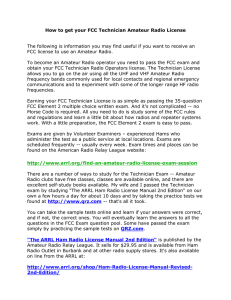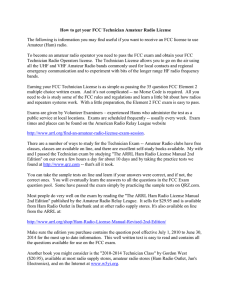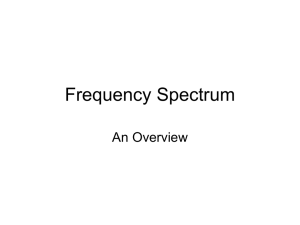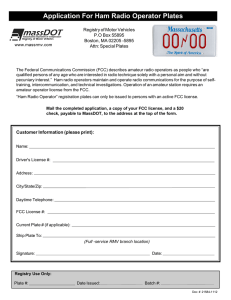2016-3-Sparks_comp - Tri-State Amateur Radio Society
advertisement
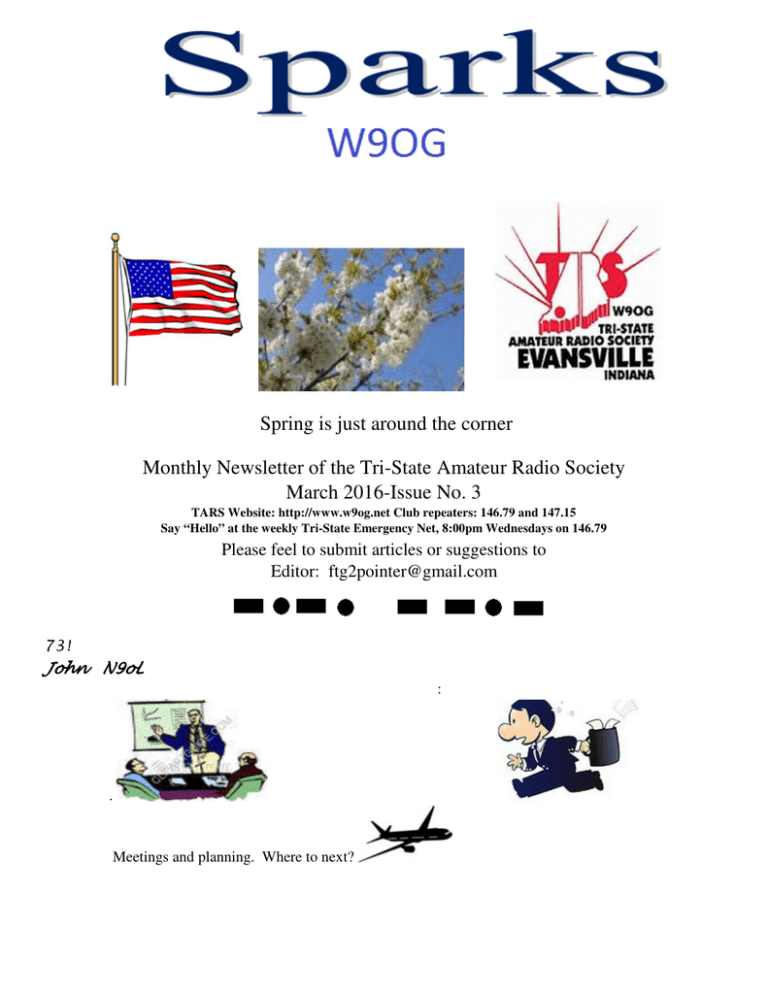
Spring is just around the corner Monthly Newsletter of the Tri-State Amateur Radio Society March 2016-Issue No. 3 TARS Website: http://www.w9og.net Club repeaters: 146.79 and 147.15 Say “Hello” at the weekly Tri-State Emergency Net, 8:00pm Wednesdays on 146.79 Please feel to submit articles or suggestions to Editor: ftg2pointer@gmail.com 73! John N9oL : . Meetings and planning. Where to next? One Man’s Opinion As always my friends, this is “One Man’s Opinion, Bill, K4LRX commonly used by radio amateurs." Anders said that room to cover the new topics was made in the question pool by dropping some questions that had been in the expiring pool. Read more. Upcoming Events -- Plan Ahead Things to look forward to: May 7, 2016 Indiana QSO Party New Amateur Extra Question Pool Puts Greater Emphasis on Digital, SDRs, Propagation The new Amateur Extra class license examination question pool, effective from July 1, 2016, through June 30, 2020, now is available at the National Conference of Volunteer Coordinators (NCVEC) website. The latest revision contains a few minor corrections that had been released in a February 5 errata of the initial January 8 release. NCVEC Question Pool Committee Chair Rol Anders, K3RA, said the new pool represents a fairly significant change relative to the current question pool, which expires on June 30. "The primary change is modernization of the pool to place more emphasis on digital communications, digital test equipment, software defined radios, and propagation/space weather," he said. "Also, a number of other topics were added, including questions on some additional antenna types Although it's not yet spring, it's time for Indiana radio clubs and individual hams to start planning for the Indiana QSO Party on May 7. Not only is this the annual running of our popular (and fun ) INQP, it's also a special celebration of Indiana's 200th birthday. And to mark that special event, we've got extra awards for working or activating our state's original 15 counties. This is a great opportunity to become "the hunted" and experience pileups on YOU ! There's a link to a powerpoint presentation on the INQP website (www.hdxcc.org/inqp, click on PUBLICIITY PACKAGE) that could be used as program material in your club. The website also holds a lot of other info, like rules for INQP, operating tips, and links to special awards, like the Worked All Indiana Counties award, or the one-time award for contacting all 15 original counties. Perhaps your club will mount a full blown effort to put your county on the air and compete for the TOP CLUB plaque. Your members can participate as individuals, and then combine their scores for a club score. You can also organize a multi-op effort, and perhaps shake out the club gear prior to Field Day. (Check out the rules and operating categories) If you are not a club member, feel free to operate and compete for individual awards, including our attractive plaques and certificates. Beside operating from home, you can go mobile, or set up bigger (and higher) antennas as a rover. Whatever your operating choice, please get on the air Saturday May 7 to put Indiana (and your county) out there for others to work. Once you have made a plan, please let me know what counties and call signs you will activate on May 7. We'll put your call on the activity map. Thanks Mel KJ9C kj9c@arrl.net April 2, 2016 April Fool Ham Fest Noble Illinois See their attachment on this news letter April meeting April meeting will be held at the west side EMA building on Harmony Way, just down the street from central dispatch. You will have a chance to see the new radio room and tour the facility. Other activities are in the planning. National Parks on the Air event: It has been suggested the club operate from Vincennes on July 31st. This will serve two things at once. 1. It will get the park on the air. 2. It is the same day the park will host a gathering of solar powered vehicles who will be making a stop at the park that day. Comments are welcomed. ARRL Field Day 2016 It was suggested that we might want to use a different location next year for Field Day. USI has been used for several years and a fresh location may liven things up a bit. This year we narrowed it down to two locations. The EMA and the Red Cross. The EMA graciously offered us the use of portable housing and a generator. We would be limited in area to set up antennas and we would have to rent a porta-potty. The Red Cross would be the outdoor area west of the building in the wooded area. Plenty of trees and open space with indoor rest rooms. Looks like the Red Cross this year. Trivia Time That new ham license was a big event in your life. For whatever reason you decided to become an amateur radio it was a great accomplishment. Let’s look back at the license …. 1. The first step is a. General b. Technician c. Advanced d. Extra 2. The first license was brought about by a. The International Telecommunications Union act of 1910 (currently called the ITU) b. The Radio Act of 1912 c. The Safety at Sea Act of 1913 d. The American Radio Relay League in 1914 3. The earliest individual radio call signs were: a. simply made up by the operator b. Assigned by the ARRL c. Assigned by the ITU d. Assigned by your State Governor’s office 4. At first amateur license was divided into three groups: a. Amateur First Class, Amateur Second Class, Amateur Third Class b. Amateur First Grade, Amateur Second Grade, Amateur Third Grade c. Beginner, Advanced and Expert 5. The Novice class license came about in a. 1921 b. 1951 c. 1981 d. 1991 6. The original three license classes were eventually changed into ____ different levels. (extra credit if you can name them) a. 4 b. 5 c. 6 7. Many hams made it to general class and never advanced. To encourage hams to move up the ladder the ARRL proposed a. easier tests b. 10 WPM code speed for Extra class c. the Incentive Licensing plan d. The license rewards plan e. doing away with licensing (it worked so well for the 11 meter band) 8. In the year 2000, to further encourage new hams and help current hams advance the FCC and the ARRL did what? a. eliminated the code requirement b. changed the code requirement from three levels to one level c. Made 10 WPM the only sped required for all classes (thus eliminating the 20 wpm obstacle for many hams) d. Allowed hams to take tests with local VE examiners instead of having to travel to FCC offices. 9. What was one valid argument to keep the code requirement? a. To keep lazy people from becoming hams b. To keep up with hams worldwide that still used it c. to offer a challenge and encourage studying and efficiency d. CW can get a message through where voice is not reliable. 10. What was a valid reason to eliminate the code? a. it was too hard to learn b. no one used it anymore c. it was an unnecessary obstacle to advancement d. Newer digital modes could get a message through as effective as the code. 11. If the FCC were to announce that all licensed amateurs will be required to pass the Technician test tomorrow, would you: a. Pass with no problem b. Pass by the skin of your teeth c. Quit ham radio all together d. Panic or hire a lawyer e. Wake up from an apparent nightmare. 12. Your current license is good for a. 5 years b. 10 years c. 15 years d. Life 13. What is the grace period if you do not renew on time? a. 6 months b. 1 year c. 2 years d. 3 years e. No grace period 14. You may renew your license a. In 90 days or less from the expiration date b. In 6 months of your expiration date c. Any time before they expire 15. You can change your call sign after an original has been issued by the FCC a. Just by filing for it b. Applying for a vanity call sign c. When upgrading your license d. When you move 16. You receive your license in two forms. a. Plastic like a credit card b. Printed in two sizes on paper c. Framed in an 8X10 frame d. by mail and by carrier pigeon. 17. Your grandson shows a lot of interest in your hobby when he comes to visit and you have let him make a few contacts. Is there a way he can operate from his home if you loan him a radio? a. Yes, if you are his control operator and he has a letter from you stating that b. Yes, he can be your unit 2 c. No. a control operator must be present when someone is operating without a license. d. No, he would probably electrocute himself or the cat. 18. If your license is lost, destroyed, ate by the dog or otherwise missing you a. Can apply for a duplicate from the FCC b. Are out of luck and have to re-test c. Can continue to operate without it d. Can draw your own copy from memory 19. If you take a test for a license and fail you a. Can take a different test (same class) for free b. Can take a different test (same class) for an additional fee c. Must wait for the next test session d. Can file for an appeal to have the FCC grade the exam 20. If you take the exam for Technician (or General) and pass, you can take the next level test a. For free b. For an additional fee c. After the other test takers in the room are finished d. At the next test session for free. Learn More: https://en.wikipedia.org/wiki/Amateur_ radio_licensing_in_the_United_States Did you know??? Johnny Cash, Famous country and western singer and performer was formally a top Morse Code operator for the Army? A very interesting story. Check it out at http://www.savingcountrymusic.com/john ny-cash-joseph-stalin-the-great-morsecode-crack/ .We have come a long way in a short time. In just a few short years ham radio has grown from a hobby of experimenters and pioneers to the modern day ham. Early hams had to make almost all of their equipment; from receivers and transmitters to antennas and transmission lines. Today’s ham has but to visit the local ham station, a nearby hamfest or go online to purchase anything needed to enjoy the hobby. As a Technician, choices are not complicated. Almost any VHF/UHF radio will do the job. However, when one transitions to HF radios, we get overwhelmed with choices and decisions. My first HF rig was the reliable Kenwood TS-520. Notice there are no MENU buttons. All switches, knobs and dials are plainly labeled as to their single function. One did have to learn how to properly tune the transmitter with the three Load, Plate and Drive controls but that was easy to master. Tubes were used in the final amplifier and they were very forgiving as you learned the ropes. If you did have any questions, the club Elmers were great about teaching you the ropes. The rig had everything a new ham needed to communicate and the 100 watt output was plenty to make contacts around the world. If you wanted extras there were several available for it online or at hamfests. Sooner or later, the desire for bigger and better with more and more features overcomes every ham. It is like your first car. It was reliable, cost effective and dependable and took you where you needed to go. But, after seeing your friends driving newer cars and listening to a constant barrage of car commercials on television you get the idea you must upgrade. Car commercials show beautiful people or families driving the latest models using all kinds of modern features; from GPS to onboard electronics and monitors. Now you are really in a quandary. As you look at the latest models you quickly become overwhelmed with choices. Many have features you may never have heard of, much less understand what they do. I was looking at my latest QST Magazine at the rigs advertised. A new Kenwood TS-990S caught my attention. Holy Cow! This unit has more Function keys than my old rig had knobs and buttons. I observed that each of the function keys had sub-function keys and menus. I thought the user’s manual for this rig must be an inch thick. If money is no problem radios are available exceeding $12,000.00 or more, that offer features previously only dreamed of or used in advanced NASA space shuttles. Remember the old car? When a problem came up you could either fix it yourself with parts available at the local auto parts store (and they could offer advice), or your local mechanic could probably have you in and out in a few short hours. With the modern 2016 Lexus or Cadillac and all their associated features, if a problem arises, you will not fix it yourself, the parts will not be inexpensive, your local mechanic may not have the necessary specialized computer equipment to diagnose it and you will most likely need a rental car while the dealer works on it. So, new hams; for your first HF radio, find a less complicated one, use it for a few months or even a few years while you learn the ropes. Take more time learning procedures, rules, radio etiquette and just having fun. When the time comes to upgrade, read reviews, talk to hams that use them or even seek out someone who has the particular radio you are interested in and see if they will let you operate it a few times. Invitation Our club has a fully operational radio room at the Red Cross, and soon to have one at the West side EMA office. We encourage members to operate from these locations a few times to get familiar with the equipment. If you are a new ham or have recently upgraded your license, but have not obtained an HF rig, one of our club Elmers can help. You can schedule a time to operate the HF bands and also have someone with you to help you learn the ropes. A win-win invitation. Trivia Answers 1. b. Technician is the first step up the ladder. Ok, so if you missed this one, better grab another cup of coffee and come back when you are awake. 2. b/ The Radio Act pf 1912 3. a. made up by the operator uniquely to identify his station 4. Amateur First Grade, Amateur Second Grade, Amateur Third Grade 5. b. 1951 6. c. the three original license classes were divided into six levels of license classes. They were Novice, Technician, General, Conditional, Advanced, Extra Class 7. c. In 1964, the FCC and the American Radio Relay League (ARRL) developed a program known as "Incentive Licensing," which rearranged the HF spectrum privileges 8. b. eliminated all but the 5 wpm speed for all levels of license. 9. d. It has been demonstrated many times that a CW signal can cut through QRM, QRN and weak signal strength much more reliable than voice modes. In the event of an emergency it may be the only reliable mode to get emergency messages across. 10. d newer digital modes can get messages through as well as if not better than CW, however CW stil wins because you only need a key, not a computer to use it. 11. Just a reminder of how easy it is to forget when you cram for an exam. 12. b. 10 years 13. c. two years, after that you start all over again. 14. a. 90 days or less before expiration date. Trying to renew before that time will not be accepted. 15. B or c 16. b. both sizes printed on one sheet. Large one to be displayed prominently near your radio station, the other may be carried in your billfold. 17. c. If he is using your call sign and you are a control operator you must be present at or near the radio 18. a. a no brainer. Simply request a copy from the FCC. Yes you could probably continue to operate without one but remember, we selfpolice and are on the honor system. 19. If you have any suggestions on where you would like for us to meet, contact Chris (KE9YK@arrl.net). Learn More: Do an online search using “simple field day antennas” for many easy to construct field day antennas. http://www.buxcomm.com/ground_plane_ca lculator.htm http://www.hamuniverse.com/jpole.html Chris KE9YK Vanderburgh Co. RACES/ARES We now have internet access at WEMA and Len N9QVQ will be updating the packet node to get internet access back online as soon as we have a network address assigned. If you have packet capability connect to N9QVQ-1 on 145.010 @1200 or 440.950 @9600. 2016 regular meeting dates: Jan 21 Feb 18 Interested in helping our community? All ARES/RACES members and any Amateur interested in emergency communications are encouraged to participate For ARES/RACES announcements you can join the Emergency Comms yahoo group at http://groups.yahoo.com/group/em ergency_comms/join Contact Chris KE9YK or John WB9EFH for more information on how you can help out. Chris KE9YK Eat'n Before the Meet'n Mar 17 Apr 21 May 19 Jun 16 Jul 21 Aug 18 Sep 15 Oct 20 Nov 17 Dec 15 Chris Lantaff KE9YK Vanderburgh Co RACES Officer (ke9yk @ arrl. Net) 626-0069 "ARRL National Parks on the Air" Event to Mark National Park Service Centennial From ARRL Letter October 15, 2015 In 2016, the National Park Service (NPS) will celebrate its 100th anniversary, and radio amateurs will be able to help mark the occasion with the ARRL National Parks on the Air (NPOTA) event. The event kicks off at 0000 UTC on January 1, 2016. "As ARRL just celebrated our own Centennial, and Amateur Radio is often enjoyed in the great outdoors, it seemed fitting to devise a program to help NPS celebrate their own 100th birthday," said ARRL Media and Public Relations Manager Sean Kutzko, KX9X. NPOTA will run throughout 2016, with activity promoted and encouraged from each of the more than 430 official NPS administrative units and affiliated areas across the US. This includes all 59 National Parks as well as National Battlefields, Historic Sites, Memorials, Preserves, Reserves, Rivers, Seashores, National Scenic Trails, and other units. The program will have two participation tracks -Chasers and Activators. Chasers will simply attempt to make contact with operators in as many of the NPS units as possible. Activators will attempt to activate as many of the units as possible. NPOTA participants may serve in both roles. Chaser and Activator totals will be tracked via an online Leader Board based on LoTW data, just as was done during the Centennial QSO Party. Access the NPOTA Leader Board directly at http://npota.arrl.org. and maintained by NPS. Complete details on National Parks on the Air are available on the ARRL website. Read more. Tri-State Emergency Net Net Operator schedule April 6 KC9TYA 13 WB9KQF 20 KC9YIL 27 N9QVQ Net operators WANTED A microphone is nothing to fear. Millions of people use them and none have been harmed by one. Put on your cowboy pants or cowgirl britches and be a net control operator. You can do it. Modeled after the Mixed DXCC award, only one contact with any given NPS unit will be required, and no tally will be kept of NPS units based on bands or modes. NPOTA will be administered entirely through Logbook of The World (LoTW). No paper logs or QSLs will be accepted for NPOTA credit. Each NPS unit will be added to LoTW as a "location." Chaser Award and Activator Award certificates will be available to any radio amateur who has at least one confirmed contact with an NPS unit or who activates at least one unit, respectively. A station's total number of confirmed or activated units will be printed on the certificate. The National Parks Honor Roll certificate will be available to any station confirming contact with at least 75 percent of the 59 National Parks activated in 2016. While there is no formal partnership between NPS and ARRL for this event, the League has been in discussions with the NPS over the past year, and the National Park Service is aware that increased Amateur Radio activity in their parks is likely during 2016. The NPOTA will use the official list of NPS Administrative Units and Affiliated Areas as defined TARS is in need of volunteers for net control operators. While we could use a couple more for the regular Wed night nets we desperately need volunteers for Skywarn/Weather nets. We have not recently had consistent weather nets I am working to change that. Weather nets are not only good for local hams to find out what coming their way but the National Weather Service depends on Hams via Skywarn to be their eyes and ears to confirm what the radar data is telling them and find out what they may be missing. If you are interested in being a control operator contact Chris KE9YK@arrl.net 626-0069. Next time there is a weather event check in on the TARS 146.79 repeater and see what is going on. Many thanks to our award winning Net Control operators. Don’t forget to check out our web page www.w9og.net 2015 Club Officers and Board members 2014 Club Officers and Board members You provide a valuable service to the club and the community. We often fail to thank you enough for your service. Keep up the good work. On the Wednesday night net you can hear the latest club information, calendar of upcoming events, topics of general interest and good old-fashioned rag chewing. If you would like to help run the net please Help is always appreciated and it is fun. Net controls: Please forward a list of your checkins to KE9YK@arrl.net thanks. Board of Directors President: John Vanvorst jcvanvorst@wowway.com 812-305-4100 cell Vice Pres: Steven Wilzbacher KC9SAW k4saw@twc.com Bob Pointer N9XAW 425-2118 (2014-2015) Mark Thienes KC9TYA 812-963-6455 (2014-2015) Terry McCrarey WB9KQF 812-760-8007 (2014-2015) Dave Vogel WA9C 812-430-5727 (2014) Herb Alvey KB9MZH 477-2757 Halvey1813@aol.com VE Test information Test dates: . 1/31/2015 2/28/2015 3 none 4/25/2015 5/30/2015 6/27/2015 7/25/2015 8/29/2015 9/26/2015 10 none 11/28/2015 12/26/2015 All ARRL examination sessions will be held at the Evansville Chapter of the American Red Cross. The ARC is located at 29 S. Stockwell Road, at the intersection of Stockwell Road and Lloyd Expressway. Sessions start promptly at 9:00 AM, Evansville time. Those candidates wishing to earn their first Amateur Radio License, or upgrade their present valid license, need to bring the following: 1. Their original signed and valid FCC Amateur Radio License. 2. Any previously earned CSCE. 3. One copy of the license and CSCE. 4. Two forms of Identification, one bearing a recent photograph. 5. The current ARRL testing fee of $15.00. You “must” have your Social Security number or EIN with you ARRL Indiana Section Section Manager: Joseph D Lawrence, K9RFZ k9rfz@arrl.org Tars mailing address: TARS P.O. Box 4521 Evansville, IN 47724 Sparks editor Bob Pointer N9XAW
